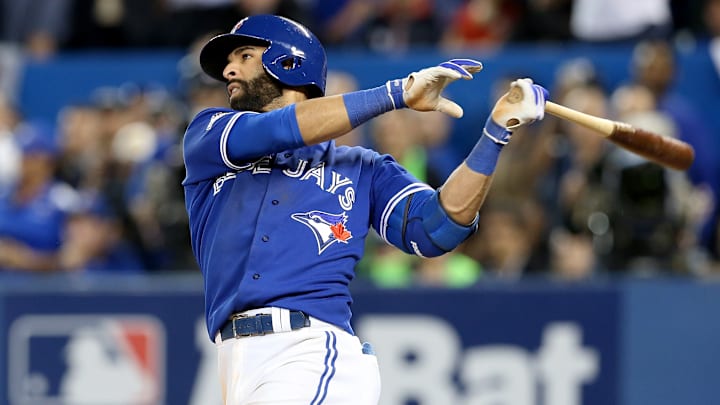Trying to rank the best outfielders in Blue Jays franchise history is like trying to pick a favorite ice cream flavor or favorite tropical paradise.
Related:
Top-five first basemen in Blue Jays history
Top-five third basemen in Blue Jays history
Top-five shortstops in Blue Jays history
The first question isn’t who should be on the list, but who shouldn’t? George Springer has provided some magical moments since he joined the club, but he’s only been with the Blue Jays for two years. And there’s the recently departed Teoscar Hernández, whose impact on the club is best reflected in the tributes and memories that poured in when he was traded this offseason.
In the 1980s, the Blue Jays featured the iconic trio of George Bell, Lloyd Moseby, and Jesse Barfield. They played together in the outfield at Exhibition Stadium for nearly a decade, helping the franchise go from expansion punching bags to the cusp of the World Series. There can’t be room for all three of them on this list, though.
There are a select few who stood out from the rest, either with their power at the plate or elite defense in the field. Here are the five greatest outfielders in Blue Jays' history.
No. 5 Devon White
If Willie Mays has “The Catch,” then Devon White made The Catch, Part II.
Game 3 of the 1992 World Series, the first World Series game played north of the border, was still tied 0-0 in the top of the fourth inning when the visiting Atlanta Braves put two runners on with nobody out. David Justice then lined the first pitch from Blue Jays pitcher Juan Guzmán deep to center field. It seemed like the Braves were going to score at least one run on the play and potentially start a big inning. But then White made the defining play of the series, what is inarguably the most famous catch in Blue Jays franchise history.
White, running at full speed, turned his back to the field as he tracked down the ball. Looking over his shoulder, he leaped off his feet, nearly colliding with the 400-foot sign on the center field wall. He turned his glove as he crashed into the wall, making a miraculous backhanded catch as the Braves’ runners scrambled to get back. White quickly fired the ball back into the infield. Terry Pendleton, on first base, passed Deion Sanders at second and was automatically out, but the Blue Jays still threw to first to make sure. Sanders took off for third but was hung up by Kelly Gruber who, instead of throwing to second, ran to tag him out.
Gruber made a diving stab just as Sanders got back to second, appearing to catch Sanders on the foot. It would’ve been only the second triple play in World Series history, but second base umpire Bob Davidson called Sanders safe. The Blue Jays got out of what seemed to be a dangerous inning unscathed and ended up winning the game 3-2 on Candy Maldonado’s walk-off hit.
More Articles About Blue Jays History:
It was the highlight of White’s five-year career with the Blue Jays, but not the only one for the Kingston, Jamaica native. The next year, White homered into the second deck in right field to tie Game 1 against the Phillies. He went 3-5 with four RBI in Toronto’s 15-14 Game 4 win, including a two-out triple in the eighth inning that drove in the winning run.
White established his reputation as one of the best outfielders of his generation in the field. He won a Gold Glove every year he played for the Blue Jays and finished with seven overall. Only Roberto Alomar has won as many in franchise history. He also had speed, eclipsing 30 stolen bases in a season three times with the Blue Jays. His 126 stolen bases are third among Blue Jays’ outfielders and sixth overall for the franchise. He was only caught 23 times, good for an 85 percent stolen base percentage.
He also had some power, twice hitting 17 home runs and driving in 60 runs on a loaded Blue Jays roster. But it’s his version of “The Catch” that will always be remembered in Blue Jays lore. “What’s actually more fun for me is I hear the story of the catch thousands of times or even more from people. It’s not just me telling the story. And it’s never really came out the same word for word from me each time, because everything was going so fast,” White told The Buffalo News 30 years later.
“You go back and you think about everything. I’ve always said that it’s not only the catch, it’s the throw and the rundown that makes everybody so excited. It would have been a triple play. But things could have changed so you never know. We’ll take what we have.”
Three decades after helping the Blue Jays win back-to-back World Series titles, White is still involved in the organization, serving as a coach with the Triple-A Buffalo Bisons since 2017.
